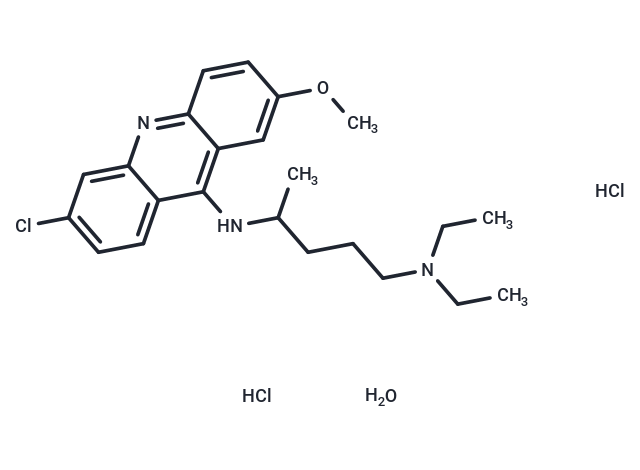Shopping Cart
- Remove All
 Your shopping cart is currently empty
Your shopping cart is currently empty

Quinacrine is a compound that is commonly used as an anti-protozoal agent. It inhibits voltage-dependent sodium channels (IC50: 3.3 μM) and suppresses aldehyde oxidase (IC50: 3.3 μM). Quinacrine prevents misfolding of prion protein (EC50: 0.3 μM). As an effective riboflavin antagonist, quinacrine associates with the riboflavin-binding protein (Ki: 6.7 μM). Voltage-dependent sodium channels play a vital role in action potential initiation and propagation in excitable cells, including muscle, nerve, and neuroendocrine cell types.

| Pack Size | Price | Availability | Quantity |
|---|---|---|---|
| 500 mg | $50 | Backorder | |
| 1 g | $56 | Backorder |
| Description | Quinacrine is a compound that is commonly used as an anti-protozoal agent. It inhibits voltage-dependent sodium channels (IC50: 3.3 μM) and suppresses aldehyde oxidase (IC50: 3.3 μM). Quinacrine prevents misfolding of prion protein (EC50: 0.3 μM). As an e |
| In vitro | Quinacrine, in a dose-dependent manner, effectively reversed the resistance in the multi-drug resistance (MDR) K562 cells. Quinacrine displayed strong toxicity to the MDR K562 cells at a concentration of 10.0 μM. Compared to the control, quinacrine significantly increased the activity of caspase-9 and -3 activities in the MDR K562 and K562 cells in a dose-dependent fashion [1]. |
| In vivo | Female BALB/c nude mice, bearing MDR K562 cell xenografts, were injected with quinacrine at a dose of 10 mg/kg via tail vein for 13 days. Compared to the control group, quinacrine inhibited tumor growth obviously in the treated groups. Furthermore, quinacrine enhanced the anti-tumor effects of vincristine [1]. |
| Alias | Quinacrine (hydrochloride hydrate) (83-89-6 free base) |
| Molecular Weight | 472.9 |
| Formula | C23H30ClN3O·2HCl [XH2O] |
| Relative Density. | no data available |
| Storage | Powder: -20°C for 3 years | In solvent: -80°C for 1 year | Shipping with blue ice. |
| Solubility Information | H2O: ≥18.65 mg/mL, Sonication is recommended. |

Copyright © 2015-2025 TargetMol Chemicals Inc. All Rights Reserved.